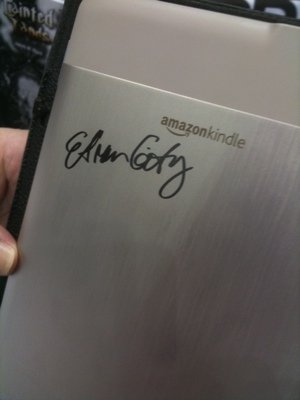A Postmodern Kindle Book selling moment
What does an author do when a reader asks if his book is out on Kindle, and he says, "Yes," and then the reader says, "Great. So will you sign my Kindle?"
Not "Can you sign my book?"--- the physical book --- but the device.
Beth Davidson of Greensboro, North Carolina, met me at the gaming convention Gen Con in Indianapolis last weekend. I was posted at booth #221 (manning some prime corner real estate generously offered by the folks at Troll Lord Games) where I was selling my book Fantasy Freaks and Gaming Geeks. Beth wanted to take home a signed copy. But she didn't want one of the signed hardcopies my signage ("GIT YOUR AUTOGRAPHED COPIES HERE") was not-so-subtly promoting. She didn't want to buy a bound paper-and-print copy of the book. She wanted to download it on Kindle.
The e-book is a concept us old-fashioned writers are gradually getting used to (some of us more begrudgingly than others), but it's a conceptual leap we're all going to have to make.But here's the twist: how does this translate to a book signing. How do you "sign" a Kindle book? How does a reader walk away with that palpable evidence he or she met an author, engaged in small talk, and was handed over physical proof of the moment? In the Kindle world, this would seem impossible. And yet Beth really wanted the signature.
"Would you sign my Kindle?" she asked.
"Uh," I paused. "Sure! Why not?"
She opened her bag and took out her shiny Kindle 2. She flipped it over to reveal its pristine, stainless steel backside. It was the first time I'd held one in my hands. The device is slim: 1/3 of an inch thick, about the width of a pencil. I took out my black Sharpie. "You really want me to do this?" I asked.
"Yep, go ahead," Beth said.
I practiced on a piece of paper first, adjusted the size of my John Hancock, and signed away. It looked pretty close to what I'd hoped for (though I sort of flubbed the "D-O-R-F" of my last name). But I consoled myself: this was my first Kindle signing. Besides, Sharpie-on-steel has a different feel than pen on paper.

"Won't it rub off?" I wondered.
"When I get home, I'll paint it with clear nail polish." That would protect it.
Beth looked happy. She thanked me, I thanked her, and off she went into the crowds of gamers and geeks.
Immediately, alarms fired off in my head. "Is this the end of civilization as we know it?" I wondered. And then I pondered this irony: my book wasn't even loaded on her Kindle yet. I had signed an empty shell that will later be filled with a digital version of Fantasy Freaks and Gaming Geeks when she buys it online (and she better buy it).
Will the Kindle revolutionize reading? Will it change the way we consume books? Perhaps. But the fact that the Kindle and other e-book readers try to look like books, with "pages" that are digital approximations of real pages, proves that we're pretty old fashioned after all. The Kindle mirrors a real book, the real world. It still wants to be a book. The Kindle 2 is only a tool -- one of several tools --- to let us store our words and ideas.
Books were already highly efficient, functional, elegant, well-crafted objects. They didn't need an upgrade to be released as Book 2.0. But progress and the marketplace makes us want to reinvent what already works best. So be it.
Looking back on it, I found my Kindle book signing ultimately a heartening moment. Despite our electronic age of data streams and pixels, we still crave the concrete. We want that signature, that mark of chisel strike on stone, ink on paper, paint on canvas. That proof that I, and you, were there. We spoke, we laughed, we shook hands.
No digital signature or pixel-scape can ever replace that.